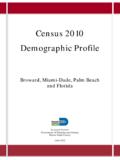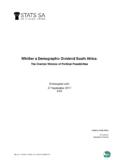Transcription of The Demographic Transition Theory
1 UNESCO EOLSSSAMPLE CHAPTERSPOPULATION AND DEVELOPMENT: CHALLENGES AND OPPORTUNITIES The Demographic Transition Theory - Chesnais Encyclopedia of Life Support Systems (EOLSS) THE Demographic Transition Theory Chesnais Senior Research Fellow, Institut National d'Etudes D mographiques, Paris, France Keywords: Transition , demography revolution, permanent desequilibrium, " Theory of thresholds", two phase reproductive Transition , modernization Contents 1. Introduction 2. Harsh criticisms, at times unwarranted 3. The main ingredients The evidence Interpretation 4. A false dichotomy 5. Some real weaknesses 6. Three central propositions The chronological sequence : mortality decline, followed by fertility decline A model of the reproductive Transition in two phases : restriction of marriages, followed by limitation of births The influence of the context of modernization on the onset of fertility decline 7.
2 Conclusion The vagueness of the notion Historical markers and conventional limits Glossary Bibliography Biographical Sketch Summary The Demographic Transition is the unique paradigm with a universal value in the field of population studies. This Theory was formulated by different authors between the 1930s and the 1950s ; it is largely based on the European experience. It encompasses two faces : a descriptive or historical one, showing the successive stages of the phenomenon ; an analytical one which aims at explaining both the mortality decline and the fertility decline. Mortality decline is clearly a precondition for fertility decline and is often accompanied by a process of adaptation through marriage limitation. The influence of the context of modernization on the onset of fertility decline take various paths, depending on the local context.
3 1. Introduction Demography is a science in which general theories are rare. Aside from Malthus s Theory which emphasizes constraints of subsistance on population as a principal body of thought -and which have proven to be inexact since its formulation in 1798 : population does not follow an exponential but a "logistic" path as expected ; food production is UNESCO EOLSSSAMPLE CHAPTERSPOPULATION AND DEVELOPMENT: CHALLENGES AND OPPORTUNITIES The Demographic Transition Theory - Chesnais Encyclopedia of Life Support Systems (EOLSS) elastic and subject to tremendous gains of productivity- there is only what is called by convention the Theory of Demographic Transition . The most important point of comparison between these two explanatory systems lies in supposed effect of economic development on fertility.
4 In the Malthusian view, economic development stimulates fertility, the increase in demand for work encouraging marriage and family formation ; that is exactly what was happening under Malthus s eyes in early industrialised Britain : there was a marriage boom and hence an increase in total fertility rates. In the transitional view, the relation between industrialization and fertility is inverse : industrial revolution raises the standard of living and stimulates, especially, a general aspiration towards an always greater degree of comfort, which, in turn, promotes the limitation of child-bearing ; this applies mainly to the XXth century reality. 2. Harsh criticisms, at times unwarranted Malthus Theory has been criticized as ceasing to be true for Europe at the very time of its conception, two centuries ago (1798) ; a more or less similar charge has arisen against Demographic Transition Theory , since the 1950 s.
5 Discussing the latter, however, is not easy, since it is one of those rare theses having multiple authorship (Landry, Notestein, Davis, Thompson : see bibliography at the end of this paper), and scientific discussion has never specified entirely which texts shoud be included in its brief. Not infrequently one or another of these authors (Landry, especially outside Europe, namely in America) is excluded from the argument ; however, he was the first not only to imagine the concept of " Demographic revolution", but also to announce that the post-transitional fertility regime would be a below replacement fertility regime. And, apart from the sometimes lenghty exegesis devoted to analysis of Demographic trends, consideration of Transition Theory itself are confined to a few laconic passages, strongly inspired by pre-war European experience, and often without claim to generality.
6 The common aim is to explain why a society passing from a timeless state of quasi-stagnation to modern economic growth (in its broadest sense as, for example, understood by Simon Kuznets and its followers : rise in real income, progress in female literacy, urbanisation, industrialization, etc) registers a decline in mortality followed by a decline in fertility, that is a two-phase Demographic modernization process. In other words, these texts offer global, liberal, non interventionist interpretation of Demographic changes assumed to have occurred of their own accord in the course of structural change in societies. This view has been the subject of heated controversies ; the World Population Conference in Bucharest (1974) marked the culmination of conflict between doctrines of development (whose ethic is summed up in the formula "the most effective contraceptive is development") and neo-malthusians, who encourage specific interventions to speed up fertility decline ; despite a considerable decline in mortality, the fertility decline in poor countries was then non existent (or unknown), a fact which called the whole Theory of Transition into question.
7 Many criticisms often lack validity, as they misinterpret and even ignore the original texts. It is useful to review the main tenets, confining ourselves to the original Theory which, by convention, focuses on Notestein s synthesis of 1953. UNESCO EOLSSSAMPLE CHAPTERSPOPULATION AND DEVELOPMENT: CHALLENGES AND OPPORTUNITIES The Demographic Transition Theory - Chesnais Encyclopedia of Life Support Systems (EOLSS) 3. The main ingredients It is possible to distinguish two approaches in these texts, the one purely descriptive, the other explanatory, which vary widely in application from one author to the other. Some confine themselves entirely to established facts, from which the claim of empirism and the reluctance to admit the theoretical status of new interpretations arose.
8 The evidence The Demographic Transition consists of a logical succession of historical phases through which every population passes in the movement towards modernity. Depending on the degree of detail in the presentation, authors distinguish three or five successive stages ; with three, one is dealing with phases of pre- Transition (long-standing equilibrium of high mortality and high fertility), Transition (destabilization due to mortality decline), and post- Transition (modern equilibrium, characterized by low mortality and low fertility). In Landry (1909, 1934), these stages are named respectively : (1) primitive regime (2) intermediate regime and (3) contemporary regime ; and the pioneering view of Landry is to assume explicitly contrary to all other authors that there is no final equilibrium, but a "permanent desequilibrium", linked to a sustained below-fertility regime.
9 In Notestein (1945), who emphasizes the influence of age structure on population growth, the three stages are defined as : (1) high growth potential, (2) transitional growth, (3) potential decline. Blacker (1949) subdivides the transitional phases into two stages, the first characterized by consistently high fertility and high but declining mortality (thus greatly expanding be rate of natural increase), and the second by a decline both in fertility and mortality, fertility being the faster of the two (the latter being a reaction to the rapid natural increase of the preceding stage). The stage conventionally called post-transitional, is also subdivided by Blacker into two stages, the first defined by an equilibrium between low fertility and low mortality, and the second by a decline in which deaths begin to outnumber births.
10 This fivefold distinction is repeated by Davis (1950) who differs only in his definition of the final phase in which fertility, while relatively low and stable, remains higher than mortality, thus maintaining a certain growth. Of course, by this time, the first three phases were a thing of the past (at least in the most advanced countries), and apparently only the last stages of the Transition were open to discussion. Thompson s threefold definition (1929, 1946) referring to "pre-industrial", "expanding" and "stationary" countries is close to Landry s classification. In other words, this first approach describes an internal dynamics of populations, drawing our attention to the influence of mortality on fertility. This relationship had been seen much earlier, for example, by Guillard, inventor of the word : "demography" (1855).

















